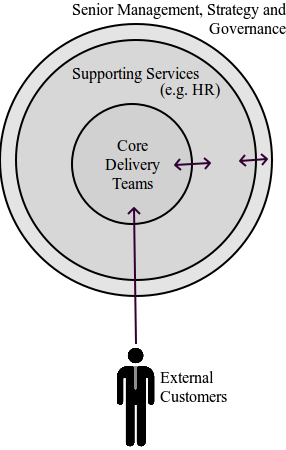The Structure of an Agile Organisation

Whether you are building an agile software department or an agile organisation, the ideal structure must minimise the layers of bureaucracy between the CEO, or equivalent, and the do'ers, whilst still remaining efficient and functional. At its core, self-organising and cross-functional teams, supported by empowering individuals with personal authority and accountability, are an effective means of achieving this agile organisational structure. Under this model, a single, mid-level manager should be capable of leading and supporting between 10-20 teams of 5-9 individuals.

Agile Team Structure
These cross-functional teams are the heart of your organisation, and should contain all the key skills required to deliver their customers’ requirements. When your Teams identify that additional skills are required to deliver a new requirement, they should have the authority to recruit, or transfer, staff with those skills into their team. New teams can be easily established by allowing a team to self-organise from existing teams (or direct recruitment) around a new set of customer requirements.
Temporary teams can also be dynamically established outside of traditional reporting hierarchies and departments. This is most useful to deliver project-based outcomes, or to develop prototype products for business research and development. After delivering their requirements, you can either convert temporary teams into a new department, or transfer them into an existing one.
This is different to the traditional hierarchical or matrix management structures, where one team would start the process, and at pre-determined stages, request input from, or handover to, another team. By passing work between silos, strict matrix organisational structures lack consistent ownership of work, cause poor communication between departments, and increase delays in the overall process.
Benefits & Risks
Benefits to this agile organisational and team structure include faster delivery times, rapid response to new issues, and improved information sharing across the organisation. An unexpected benefit that I have found is the cultural shift in loyalty from a single team or manager, to loyalty to the customer and organisation. However, to realise these benefits requires that all team members are committed to the outcome, and adaptable in their role.
As with everything, cross-functional teams are not without their risks. Understaffed teams may not be able to deliver all the requirements that the customer needs. A team may be lacking individuals with needed, specialised skills, or individuals may be unable to dedicate the time required to the team, through either unplanned leave, or other corporate (non-customer) requirements.
Management
So far, I have mostly talked about the delegation of authority to empowered teams; what then, is the role of management in an agile organisation? Each department, whether it supports internal or external customers, needs management (dare I say leadership) at an appropriate level. For example, a HR department may have two teams, and multiple internal customers, but still requires a single manager who is responsible for staff performance management, initial customer & stakeholder engagement, and financial management & delegation. Ultimately, it is you, the agile manager, who is responsible for empowering, inspiring and leading your teams.
Want to know more about this; check out my book "Directing the Agile Organisation" - published by ITGP.
Attribution
Image is CC BY NC SA - jairoagua (flickr)